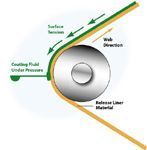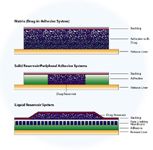The Growing Importance Of Release Liners In Pharmaceutical Manufacturing
Pharmaceutical Technology Europe
With the increasing importance of novel dosage forms, the use of release liners as components of transdermal delivery systems, oral thin films and buccal mucosal systems is on the rise.
Manufacturers across the pharmaceutical industry employ a variety of techniques to create safe, efficacious products. Frequently, processing aids are employed to help maintain the integrity of the dosage form during manufacturing.
Martha Sloboda

Release liners, also referred to as simply liners, are one such processing aid that have been an integral part of transdermal product design since the first commercially available transdermal patch product was approved by the FDA in 1979. These liners frequently serve as both processing aids and final components in transdermal patch systems.
Typically, release liners are a siliconecoated polyester or paper product, and their value and use for transdermal patch systems are well understood. However, the use, chemistry and benefits of release liners as a processing aid and/or component for new, liquid cast dosage forms — particularly oral thin films (OTFs) and buccal mucosal systems — is growing in importance as the use of these applications become more widespread.
More than just a film or paper
A release liner is a web of sheet material that covers the adhesive side of a pressuresensitive adhesive (PSA) tape product to provide a protective surface during storage and transit, as well as to provide functional support during manufacturing and converting.1 Developed originally for industrial PSA tape and label applications, liners quickly became an essential processing aid in the adhesive casting process. In this scenario, a bulk liquid adhesive formulation is coated or cast onto a continuous web of liner material that is then run through a drying tunnel until the desired dryness and adhesive tack characteristics are achieved (Figure 1). In label applications, the web is then laminated to a label "face stock" material, typically a paper or film, and then wound into rolls for transport and conversion. The successful conversion of a PSA product is fully dependent upon the integrity of the release liner because it must resist the force of the cutting die, while withstanding the speed and rigour of processing. Depending upon the needs of the end application, the liner may remain intact with the rolled adhesive tape product until the point of application, or it could be removed during finishing and converting. Most PSA labels leave the release liner component intact to aid in application.
The key performance criteria for release liners in any application are:
- the liner must have consistent contact with the product until it is deliberately removed
- upon removal, the adhesive should remain intact, with no residual adhesive or polymer remaining on the liner
- the liner should not change the chemical nature of the adhesive.
The use of release liners, and their associated safety and performance criteria, grew as adhesive products entered the medical arena with the introduction of more sophisticated wound dressings, EKG monitors and device applications.

Figure 1: Casting onto release liner.
With the advancement of transdermal drug delivery in the 1980s, the use and requirements of release liners took on a new dimension. In addition to the standard technical performance requirements, new safety and regulatory considerations for release liner components quickly became paramount. Adhesives and film manufacturers dedicated extensive development resources to identify and characterise materials that would be acceptable for use in pharmaceutical applications to ensure that the drug product remained stable, the delivery system easytouse, and the chemistry safe for use on or around humans. Developers adopted liner technologies from the electronics industry where ultraclean and low or nooutgassing liners were vital for maintaining electronic component integrity. In addition, liners and liner components were evaluated against the standard tests for adhesives such as cytotoxicity, skin irritation and so on. New companies emerged with chemistries and technologies wellsuited for providing an ultraclean, consistent product comprised of pharmaceutically acceptable components.

The author saysâ¦
As even more advanced and active transdermal delivery technologies enter the market, the utilisation and function of release liners in pharma applications has evolved in response to the manufacturing demands of these technologies. Whether or not release liners remain a component of the final assembled system, the critical nature of their function remains the same. They provide integrity and strength to the multitude of rolled goods that are manufactured, repeatedly handled, converted, and finally integrated and assembled into a sophisticated delivery device. Liners can also serve as a layertolayer protective barrier to prevent materials from intermingling or interfering with one another.
Aside from their many process benefits when manufacturing delicate or tacky materials, release liners are emerging as a critical component in OTFs and buccal delivery systems. The launch of the Novartis Thin Strips in 2004 was due, in part, to developing sophisticated liners that could enable a robust, costeffective process for producing and packaging dissolvable films.
This next generation of liner development has focused on creating materials that are safe as processing aids for oral delivery forms and that are also able to maintain the perfect level of adhesion with an inherently tackless product through the stresses and rigours of the manufacturing process.
Release coating chemistry
Release liners can be composed of a number of different base materials and chemistries. The basic construction of a release liner is that of a base stock, tie or binding layer, and release chemistry. The release coating, generally a silicone, is applied to one or both sides of the base material. Speciality papers, plastics and Teflon substrates are the most commonly used base materials in the pharmaceutical and medical arenas.
The application and curing of the release chemistry or coating to the base liner material includes solventbased, waterbased, or solventless approaches.2 Conventional release coatings are comprised of:
- a pre-polymer polydimethylsiloxane with functional groups of hydroxyl or vinyl at the ends and/or along the polymer chain
- a short-chain hydrogen-functional pre-polymer cross linker
- a catalyst
- an inhibitor.
The types of catalysts used vary greatly from industrytoindustry and continue to evolve, particularly within the pharmaceutical arena.
Key considerations
Selection of the appropriate liner is critical to ensure the technical, operational and regulatory success of any product. All three elements must be considered at the outset.
The performance purpose of the liner defines the key technical considerations and will influence operational decisions. For example, is the liner strictly a processing aid intended to protect and provide support for handling the drug product through processing? Or, is the liner intended to be a component of the final dosage format, so ease of use by the patient is as critical a consideration as providing dependable processing performance?
Ultimately, the chemistry of the material that makes direct contact with the release liner will define the final tightness and release properties. For example, an adhesive or product with adhesivelike traits will require a different release value than an inherently tackless OTF product. The standard measure for release liner performance regardless of applications must consider:
- Tack – the property of a PSA that enables it to adhere to a surface under very slight pressure. Tack is determined by the ability of the adhesive to "wet out", or make intimate contact with the surface it contacts.
- Shear – the time required, under specified test conditions (surface area, weight load), to slide a standard sized PSA tape sample from a flat surface in a direction parallel to the surface.
- Release force – the measure of the force required to separate a unit width of PSA tape from a release-coated surface at a controlled angle and speed.1
The product development team will typically start with standard American Society of Testing & Materials (ASTM) methods, as well as European equivalent standards, for adhesives to understand product performance. However, these methods will frequently be adapted for products with nonstandard chemistries or specifications outside of commonly understood ranges. An important note is that these methods can only provide general guidance — particularly for applications where the liner will be subjected to the variability of the patient population.
Regulatory considerations
The region of sale and the final dosage format of the drug product will ultimately impact the potential liner chemistries that are acceptable for use. In addition, the product development team must understand if the liner is to be used as a processing aid to be disposed of during manufacture, or if it will remain with the product throughout its shelflife. Understanding where and how the liner will be used provides the boundaries for acceptable chemistries.
In general, transdermal products have at least one release liner that remains with the product until point of use. Primarily considered part of the packaging, the release liners must withstand the stability standards set for the final unit dosage form. Additionally, the release liner makes direct contact with the delivery system, so as a component it must remain chemically inert3 without outgassing, leaching or absorbing any materials when exposed to the product's excipients, API or drug product (Figure 2).

Figure 2: Release liners in transdermal drug delivery devices.
In comparison, OTF products frequently employ release liners strictly as a processing aid that is removed prior to final product packaging. The liner acts as both a support and protective barrier between the delicate, thin layers of rolled film that are sensitive to humidity and moisture (Figure 3). In the manufacture of OTFs, the release liner provides strength and support to the product until the master roll of OTF material is unwound and converted into individual strip doses and packaged. Nonetheless, the minimum standard of care in selecting a liner and liner chemistry in an OTF application is to ensure that the liner and its release coating are safe for direct food contact.

Figure 3: Oral thin film construction.
Outside of the US, additional considerations must be met for the release coatings as part of liner development. One example of this is in the silicone chemistries employed as they vary in the types of binding agents and relative ratios used to produce a consistent, inert, stable liner coating. Understanding a release liner's catalyst — its acceptability for use and remaining residuals — is particularly critical for oral dosage formats. Fortunately, there are several global liner suppliers to the pharma industry capable of guiding a technical team with acceptable chemistries.
Operational considerations
In the manufacture of transdermal adhesives and OTFs, release liners are utilised for liquid casting and in the subsequent removal of solvents during the drying process. The solvent system of the bulk polymer or polymer+API blend ranges from 100% organic to 100% aqueous, with the opportunity to employ co-blends as warranted. The liner acts as both a carrier and surface for the liquid to evenly flow across to create a uniform casting. To do this, the liner's surface chemistry must not impede the ability of the liquid to uniformly disperse. Likewise, the surface must not be overly hydrophilic to prevent the fluid from adhering to the release liner. Finally, the liner material must allow for effective removal of the desired percentage of solvent from the cast fluid. The product development team must assess how all of these needs define the required properties of both the base liner material and the associated silicone chemistry.
Once the liquid material is effectively dried, the product is generally rolled into an intermediate roll, which, either individually or in combination with other materials, is converted into a final dosage format. The converting process may expose the intermediate roll to a number of twists, turns and tensions, as well as potential changes in temperature. In a transdermal system, the liner must adequately adhere to the patch throughout the process. Conversely, OTF applications require a clean removal of the liner from the film prior to pouching.
Often stability programmes are expanded to evaluate liner performance for the intermediate product. A critical look at the stability of the liner/product interface in larger bulk rolls provides the design team with information on the optimum processing window for a given product. In some cases, the stability profile may open up liner options for the product if, even under stress, the interface is rugged.
To sum up
Few processing aids can improve manufacturing efficiencies for drug delivery systems and their components than release liners. The flexibility in their chemistries and application continues to evolve, opening the possibility for even more innovation in the realm of cast delivery formats. This same flexibility, however, can complicate a liner's selection and use in a system. Teams working on cast systems must start the liner assessment, definition and selection process early to rigorously define the critical performance parameters. While understanding a liner's performance may seem to be a daunting challenge, there are extensive resources available to development teams, including liner and silicone chemistry suppliers, manufacturers of transdermal patches, crossindustry associations such as the Pressure Sensitive Tape Council (PSTC), and even contract manufacturing groups experienced in producing transdermal, OTF and buccal products.
Release liners enable new drug dosage formats to enter the marketplace. While ultimately a discarded piece of the puzzle, they provide the backbone to products that otherwise could not be handled by manufacturers, or, more importantly, the patients ultimately benefiting from the product.
Martha Sloboda is Business Manager at ARx LLC, Glen Rock, PA (USA). Tel: +1 717 227 3326 msloboda@arglobal.com
References
1. G.M. Orlych, Adhesives and Sealants Industry, 11, 22–27 (2004).
2. A. Kuo, Silicone Release Coatings for the Pressure Sensitive Industry – Overview & Trends (Dow Corning Corporation). www.dowcorning.com
3. S. Kandavilli, et al., Pharm. Tech. 26(5), 62–80 (2002).

Drug Solutions Podcast: A Closer Look at mRNA in Oncology and Vaccines
April 30th 2024In this episode fo the Drug Solutions Podcast, etherna’s vice-president of Technology and Innovation, Stefaan De Koker, discusses the merits and challenges of using mRNA as the foundation for therapeutics in oncology as well as for vaccines.